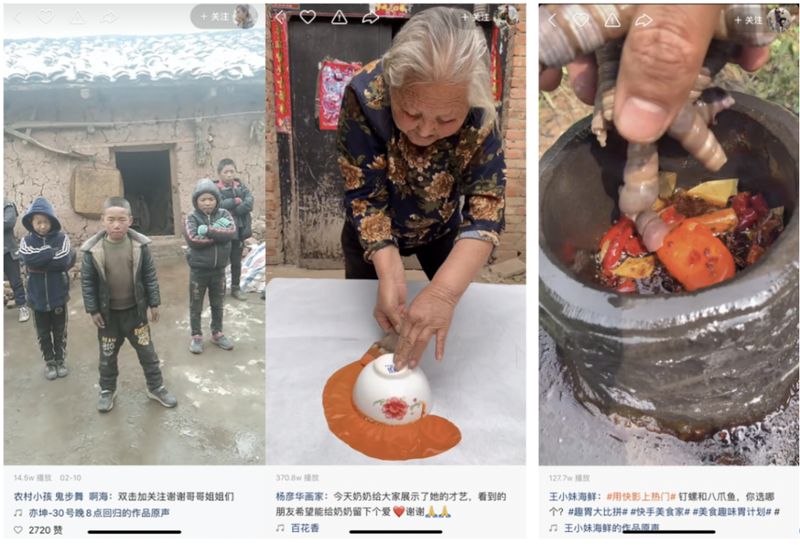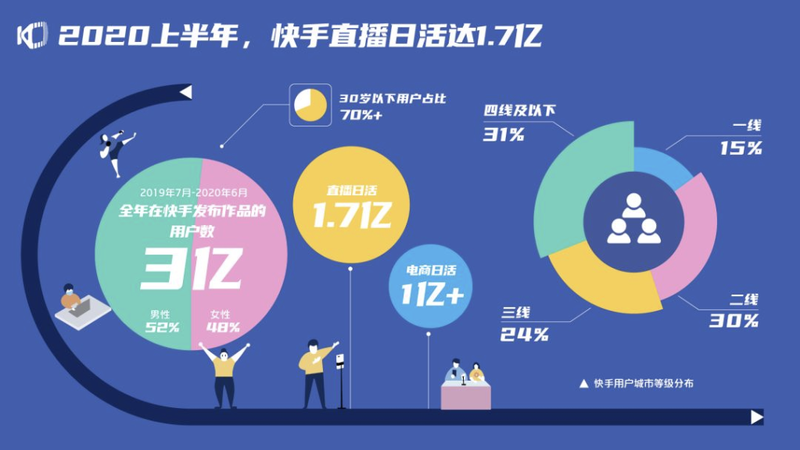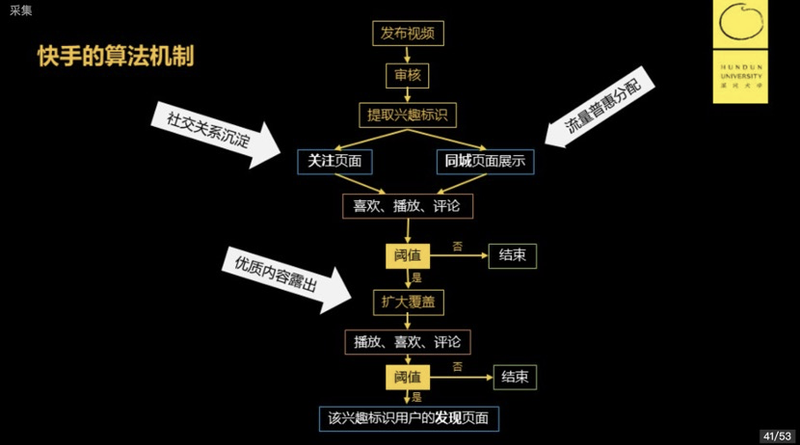icon
password
Multi-select
tags
ID
type
status
slug
summary
category
date
Author
URL
Editor’s note:
Even if you haven’t used it, you must have heard the name TikTok. The app from ByteDance has swept the world, including its hometown of China. According to third-party data, Douyin, the Chinese version of TikTok, has more than 400 million daily active users in China.
Overseas, TikTok is synonymous with short videos. However, there is another short video App–Kwai (Kuaishou) in China.
This short video app, released earlier than Douyin, had more than 300 million daily active users in 2020.
Like Pinduoduo, Kwai’s success reflects the rise of China’s third-tier cities and rural areas. Although it looks similar to the well-known TikTok in appearance, the product has a completely different product logic and user base.
In some areas, it has even replaced WeChat, as the product most similar to the Chinese version of Facebook. Some villages use this App for daily communication.
Meme Xue Hua Piao Piao and Egg Man, which were popular overseas some time ago, came from Kwai rather than Tiktok.
It is the opposite of the reason why TikTok is so popular in Generation Z. In Chinese, watching and shooting videos are significantly more acceptable than typing and reading, which makes Kwai a real way for people with low network literacy to get access to the Internet in the rural market.
This article will show you how it beats TikTok in these areas.
PS : Kwai is actually an overseas version of Kuaishou, and the two data are not shared, just like TikTok and Douyin. In this paper, Kwai is referred to as Kuaishou. The company also has another overseas app, Zynn.

Kuaishou’s Logo
This article was originally writen by the Chinese media Tencent Research Institute (腾讯研究院) and translated by PandaYoo.com after it was licensed. Copyright belongs to the original author and it is forbidden to reprint without permission.
Author: Qianqian Yu
Stories of technological progress often begin in first-tier cities, like communication tools, e-commerce services, online entertainment.
Every Internet technology application carries a distinct brand of urban lifestyle, and then gradually spreads to other lower-line cities and rural areas.
However, little attention has been paid to whether the application of new technology with obvious urban characteristics can adapt to the rural field.
China has a rural population of 566 million. By the end of 2018, the scale of rural netizens reached 222 million. However, the daily life and mental outlook of these people did not enter the mainstream discourse system of the Internet for a long time, until the emergence of Kwai: muddy children dancing in the fields; centenarians writing and painting; young boys cooking in the field.

Some videos on Kwai have a completely different style from TikTok.
“They are fresh, amazing and sometimes even hard to be accept. I think it’s normal. Our world is too fragmented, “said Zhang Fei, an investor in Kwai.
Serving this group, showing the living state of the so-called “people outside the five ring road” so that they have the opportunity to be seen and paid attention to has become the value choice of Kwai, that is, the “traffic inclusive” strategy – giving each content producer fair exposure opportunities and encouraging the diversity of content shooting in the whole platform.
In 2013, “Gif Kwai” transformed from a tool to a short video community. In 2016, the number of Kwai users exceeded 300 million. According to the “2019kwai content report” in February 2020, the daily life of Kwai has exceeded 300 million. According to the 2020kwai content ecological semi annual report in July 2020, the proportion of Kwai users in the first tier, second tier, third tier, fourth tier and lower tier cities is 15%, 24%, 30% and 31% respectively.

Only 15% first tier cities live in Kwai
Similar to many other Internet content businesses, short video is essentially an attention economy.
“Attention” is the innate ability of human beings. Everyone is the producer and consumer of attention. Getting more attention means stronger influence, more resources and wealth. As a reflection of the real world, the phenomenon of uneven distribution of wealth is reflected in the uneven distribution of attention on the Internet. In other words, a few people control the flow inlet.
As a multi-party connector, short video platform can control the gate of traffic. However, for the sake of distribution efficiency, “hot content recommendation” is often the mainstream choice – the platform side or a few people decide what users watch. The top content is generally high popular culture, such as social hot spots and star’s update, which can quickly attract people.
In this mode, the right of content production is concentrated in the hands of a few head creators, and a professional short video production system is gradually formed.
See Also: When the algorithm dominates all content
But Kwai’s content distribution mechanism is slightly different. It is more like a short video version of “Wechat moments”. It allows you to follow the hot content of the day, as well as see friends’ updates and recommendations in the local community. This means that not only head creators are being paid attention to, but ordinary creators can also be discovered, followed and pushed by the platform, which is the so-called “traffic inclusive”.
“Traffic inclusive” was once the underlying value of Kwai, which dominates the product design, algorithm logic and operation ideas of Kwai, and another possibility of traffic distribution. This paper will systematically sort out the product logic, innovation value and limitations of “traffic inclusive”.
“Gini coefficient”: the Law of Traffic allocation
When a UGC (ordinary User-Generated Content) platform has enough users, it is actually faced with a choice: from the viewer’s point of view, choose some exquisite “candy” to feed them and induce them to pay more attention. Or from the standpoint of producers, so that every topic is not only a large flow of topics, but also many subdivided topics, and even the daily content of ordinary people can be pushed as much as possible, so as to encourage them to continue production.
Most video App chooses the former and Kwai chooses the latter.
The people it wants to serve are not only users who simply “have fun”, but also “recorders” who are willing to record and share their lives. Even, in Kwai’s original idea, compared to “Internet celebrities” and “Professional creators”, these recorders are the higher value users.
These ideas are reflected in product design: giving the average creator more and more reasonable exposure, which means matching more and more accurate viewers for the creator.
Kwai adopts the traffic distribution strategy of “setting upper limit”, commonly known as “Gini coefficient” mechanism. The “Gini coefficient” is an indicator used to measure the distribution of wealth in economics. Kwai applies the concept of Gini coefficient to traffic allocation: when the number of short videos reaches a certain threshold, the exposure will be automatically reduced, allowing traffic to benefit new high-quality works.
For creators, Kwai takes traffic suppression measures for head creators who have millions of followers. Head videos with a playback volume greater than 500,000 are only allowed to account for 30% of the total number of videos played on the platform, and the remaining 70% are given to ordinary creators.
Therefore, there is little difference in the number of long-term fans between the medium-sized creator and the head creator. According to the Kwai Creator Business value report released in October 2019, 0.14% of creators have more than 10 million fans, and 0.32% have 5 million-10 million fans.
“Wechat moments in the county”: social support traffic entrance
The essence of “traffic inclusive” is to give ordinary creators the opportunity of “popularity”. Specifically, it is to give undifferentiated traffic distribution in the early stage of creation, and gradually find the audience suitable for each content.
The Gini coefficient strategy solves the problem of who has more traffic and who has less traffic, while the Local function solves the problem of traffic adaptation.
A large number of short videos of small and medium-sized creators are recording daily life, which is far from the professional and exquisite level of TV programs. What kind of viewers will such content attract? The answer must be a group with the same living background, cultural customs and entertainment style as the publisher. In lower-level cities, “geographical relationship” is the best way to establish similarity.
Kwai’s “Local” page started here, and its essence is short video social networking based on geographical location. Compared with TikTok, “Local” has always been an important traffic inlet of Kwai, and plays an irreplaceable role in the process of cold start.
The so-called “cold start” means that the video uploader can get 200-300 exposures without fans, almost all of which come from local channels. Simple understanding, we can think that many of the head of the early network red, are inseparable from the traffic from the local community.

On the one hand, “Local” has become the most important traffic entrance after the “Followed” and “Discovery”. The difference is that geo features help it establish “county moments” and “old fellow chain”, so it has strong social attributes. On the other hand, it can transfer the online relationship chain to the offline real consumption scenario, which has a strong liquidity potential.
Where will “traffic inclusive” lead to?
“Ordinary people’s star scout, trend engine”, this is Kwai Senior Vice President Ma Hongbin’s interpretation of “traffic inclusive”, but this is only the appearance of “inclusive”, and a whole set of product mechanism and business strategy behind it are the real core. “Traffic inclusive” is the underlying value of Kwai. Algorithm design and product functions are all around this core value. The “de-headedness” and “local” mentioned above actually form a community atmosphere for Kwai, rather than make it like a video media.
[sociallocker id=”5614″]
This is why Kwai prefers to call itself a short video community – countless small creators centered communities have jointly constructed the Kwai community, which is not an entity’s “group chat”, but a description of the relationship network.
A wave of “fan satellites” generally surround the creators, forming a network of relationships. They have common expectations and close communication, instead of all users chasing a few popular creators and head content. The formation of this kind of community is the direct result of the above repeatedly mentioned suppression of head traffic and setting of local traffic entrance. “Old fellow chain” and “county circle of friends” are the characteristic descriptions of the community structure on Kwai, which reflects the stickiness between creators and fans.
In the course of the development of Internet products, “media form” has always been the opposite concept of “community form”. The media has a clear content center and hype guidance, and users consume content. In the community, users not only consume content, but also the people behind the content. In the current content products, there is no clear distinction between community form and media form, but there are huge differences in user habits and realization path.
And the community form promoted by the “traffic inclusive” strategy finally threw out the soul torture on the way to realize Kwai: how to improve the commercial income under the condition of ensuring the live broadcast income?
In 2019, the total revenue of Kwai will reach 50 billion yuan, the live broadcast revenue will be close to 30 billion yuan, and the advertising revenue will be about 13 billion yuan. According to the semi annual report of 2020kwai content ecology released by Kwai big data research institute, as of July 2020, the daily live activity of Kwai has reached 170 million, and the daily activity of e-commerce has exceeded 100 million.
This just reflects Kwai’s product structure – live broadcasting revenue, which is mainly reward oriented, accounts for the largest part of the total revenue. It is not difficult to understand that the “reward” behavior reflects the interaction and trust between people. Based on this mutual incentive, users have the idea of giving gifts, so they have the motivation to pay.
However, the other side of the increase in live broadcasting revenue is that the power of commercialization is not strong enough. Commercialization mainly refers to advertising marketing, which relies on a large amount of exposure of the head content and has a strong media attribute. Kwai insiders are also honest that the commercialization of Kwai started late and was established in 2011, but the comprehensive construction of the commercialization system was not completed until 2019.
Today, “traffic inclusive” is still an important strategy for 9-year-old Kwai. In the past nine years, Kwai has developed from a start-up team with only a few people to a technology company with more than 10000 employees. The social well-being brought by the flow inclusive is obvious to all. It uses a set of technical solutions to redistribute the attention of netizens, so that more cameras and eyes are focused on ordinary creators.
At the same time, the feedback from the capital market is also constantly testing its commercial ability. Similarly, Kwai faces challenges. In October 2019, Kwai is still launching an impact for the 300 million daily living. By may 2020, Kwai announced the organizational structure adjustment, trying to further the ability from product to operation to commercialization. In the outside world, Kwai has become more wolf like. On the user side, we can clearly perceive that Kwai is accelerating its pace in product adjustment.
It’s just that before everything is settled, it remains to be seen where Kwai’s future will lead.
[/sociallocker]
- Author:NotionNext
- URL:https://pandayoo.com/2020/08/21/kwai-a-short-video-application-used-by-another-300-million-chinese
- Copyright:All articles in this blog, except for special statements, adopt BY-NC-SA agreement. Please indicate the source!